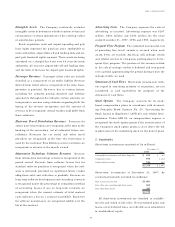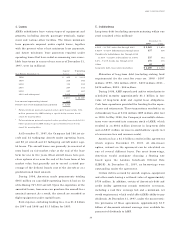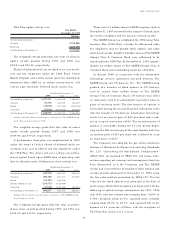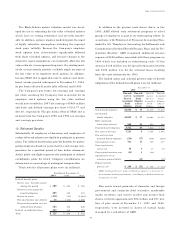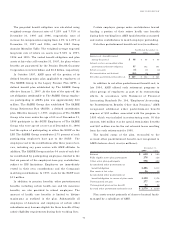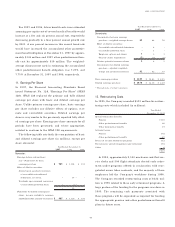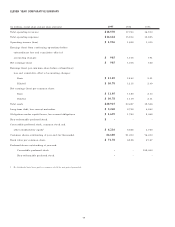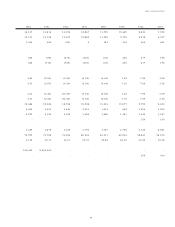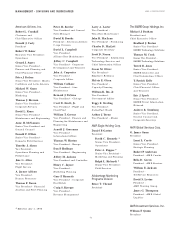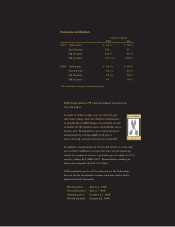American Airlines 1997 Annual Report Download - page 65
Download and view the complete annual report
Please find page 65 of the 1997 American Airlines annual report below. You can navigate through the pages in the report by either clicking on the pages listed below, or by using the keyword search tool below to find specific information within the annual report.
AMR CORPORATION
63
For 1997 and 1996, future benefit costs were estimated
assuming per capita cost of covered medical benefits would
increase at a five and six percent annual rate, respectively,
decreasing gradually to a four percent annual growth rate
by 2001. A one percent increase in this annual trend rate
would have increased the accumulated other postretire-
ment benefit obligation at December 31, 1997 by approx-
imately $144 million and 1997 other postretirement ben-
efit cost by approximately $19 million. The weighted-
average discount rate used in estimating the accumulated
other postretirement benefit obligation was 7.25% and
7.75% at December 31, 1997 and 1996, respectively.
11. Earnings Per Share
In 1997, the Financial Accounting Standards Board
issued Statement No. 128, “Earnings Per Share” (SFAS
128). SFAS 128 replaced the primary and fully diluted
earnings per share with basic and diluted earnings per
share. Unlike primary earnings per share, basic earnings
per share excludes any dilutive effects of options, war-
rants and convertible securities. Diluted earnings per
share is very similar to the previously reported fully dilut-
ed earnings per share. Earnings per share amounts for all
periods have been presented, and where appropriate,
restated to conform to the SFAS 128 requirements.
The following table sets forth the computation of basic
and diluted earnings per share (in millions, except per
share amounts):
Year Ended December 31,
1997 1996 1995
Numerator:
Earnings before extraordinary
loss - Numerator for basic
earnings per share $985 $1,105 $ 191
Effect of dilutive securities:
Interest upon assumed conversion
of convertible subordinated
debentures, net of tax -14(a) -
Dividends upon assumed conversion
of convertible preferred stock -1 (a) -
-15 -
Numerator for diluted earnings per
share - income available to common
shareholders after assumed conversions $985 $1,120 $ 191
Year Ended December 31,
1997 1996 1995
Denominator:
Denominator for basic earnings
per share - weighted-average shares 89 86 76
Effect of dilutive securities:
Convertible subordinated debentures -4 -
Convertible preferred stock -1 -
Employee options and shares 73 3
Treasury shares repurchased (5) (2) (2)
Dilutive potential common shares 26 1
Denominator for diluted earnings
per share - adjusted weighted-
average and assumed conversions 91 92 77
Basic earnings per share $11.05 $12.83 $ 2.51
Diluted earnings per share $10.78 $12.15 $ 2.49
(a) Through date of actual conversion
12. Restructuring Costs
In 1995, the Company recorded $533 million for restruc-
turing costs which included (in millions):
Year Ended
December 31, 1995
Special termination benefits:
Pension $ 118
Other postretirement benefits 26
Other termination benefits 19
Actuarial losses:
Pension 102
Other postretirement benefits 67
Total cost of early retirement programs 332
Provisions for aircraft impairment and retirement 193
Other 8
$533
In 1995, approximately 2,100 mechanics and fleet ser-
vice clerks and 300 flight attendants elected early retire-
ment under programs offered in conjunction with rene-
gotiated union labor contracts, and the majority of these
employees left the Company’s workforce during 1996.
The Company recorded restructuring costs of $332 mil-
lion in 1995 related to these early retirement programs. A
large portion of the funding for the programs was done in
1995. The remaining cash payments associated with
these programs will be expended as required for funding
the appropriate pension and other postretirement benefit
plans in future years.
(a)


